Here you'll find a set of pictures I've taken myself featuring HP calculators from my own personal collection, together with useful details and my (hopefully interesting) anecdotes and comments on each particular model, including links to relevant materials (Articles, Brochures, Challenges) previously uploaded by me to this site.
Also, the very first pictures in this Section feature partial views of the truly impressive collection gathered by my life-long friend Jose Luis Chinchilla (JLC), and for the sake of completeness some of the models featured here are also from his collection, mainly the ones I don't own, which are duly identified as his in the pictures' descriptions. Enjoy!
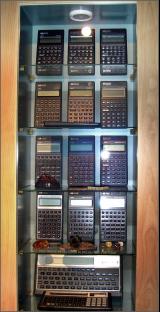
This is part of the impressive and extensive HP calc collection assembled and maintained by my life-long friend Jose Luis Chinchilla. Mind you, the individual calcs whose pics are featured below in this Section are mostly from my very own collection, which is not as comprehensive as his (for instance it does not include any financial models except for the HP-12C, and no computer-like models except for the HP-71B), but for the sake of completeness some of the models I don't own are from his collection and they're identified as such in the relevant pictures' descriptions.
Here you can see such models as the HP20S, HP10B, HP14B, HP17B, HP27S, HP32S, HP32SII, HP42S, HP-75C and HP-71B, among others.
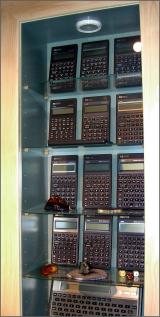
This is part of the impressive and extensive HP calc collection assembled and maintained by my life-long friend Jose Luis Chinchilla. Mind you, the individual calcs whose pics are featured below in this Section are mostly from my very own collection, which is not as comprehensive as his (for instance it does not include any financial models except for the HP-12C, and no computer-like models except for the HP-71B), but for the sake of completeness some of the models I don't own are from his collection and they're identified as such in the relevant pictures' descriptions.
Here you can see such models as the HP20S, HP10B, HP14B, HP17B, HP27S, HP32S, HP32SII, HP42S and HP-75C, among others.
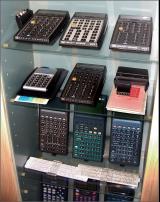
This is part of the impressive and extensive HP calc collection assembled and maintained by my life-long friend Jose Luis Chinchilla. Mind you, the individual calcs whose pics are featured below in this Section are mostly from my very own collection, which is not as comprehensive as his (for instance it does not include any financial models except for the HP-12C, and no computer-like models except for the HP-71B), but for the sake of completeness some of the models I don't own are from his collection and they're identified as such in the relevant pictures' descriptions.
Here you can see such models as the HP-41C, HP-41CV, HP-41CX, HP-41C "Blanknut" and their card reader plus blank cards in their card holder, as well as the HP 38G, HP 39G and various RPL and misc models, with a couple of slide rules thrown in for good measure.

This is part of the impressive and extensive HP calc collection assembled and maintained by my life-long friend Jose Luis Chinchilla. Mind you, the individual calcs whose pics are featured below in this Section are mostly from my very own collection, which is not as comprehensive as his (for instance it does not include any financial models except for the HP-12C, and no computer-like models except for the HP-71B), but for the sake of completeness some of the models I don't own are from his collection and they're identified as such in the relevant pictures' descriptions.
Here you can see such models as several HP-35, HP-80, HP-45, HP-70, HP-65, HP-55 and HP-67, among others.
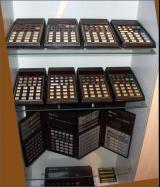
This is part of the impressive and extensive HP calc collection assembled and maintained by my life-long friend Jose Luis Chinchilla. Mind you, the individual calcs whose pics are featured below in this Section are mostly from my very own collection, which is not as comprehensive as his (for instance it does not include any financial models except for the HP-12C, and no computer-like models except for the HP-71B), but for the sake of completeness some of the models I don't own are from his collection and they're identified as such in the relevant pictures' descriptions.
Here you can see such models as the HP-31E, HP-32E, HP-33E, HP-33C, HP-34C, HP-37E, HP-38E, HP-38C, HP19BII and HP28S, as well as a misc HP-94 at the very bottom just for show.

This is my HP-10C, the simplest HP Voyager series' model and the last to be released back in 1982. After 40 years (as of 2022), it still looks and works great.
Unbelievable quality for such modest unit and its very simplicity (just the one yellow prefix key) in the iconic landscape Voyager form factor make it a very appealing calc to behold, I know that I like it very much. And as it didn't sell well it's become a very rare vintage calc indeed, you'd be hard-pressed to find one in mint shape like the one shown above.
Anyway, despite its simplicity it still boasts the same awesome physical quality, including "eternal" battery duration, but it has a much reduced function set and capabilities as compared to the HP-11C (let alone the HP-15C), though still programmable and featuring all the usual scientific and statistic functions (including linear regression), engineering display mode and flexible storage allocation (from 10 storage registers and 9 lines of program memory to no registers and 79 lines).

This is my HP-10C, the simplest HP Voyager series' model and the last to be released back in 1982. After 40 years (as of 2022), it still looks and works great.
See the full description and other details in the link above this one.
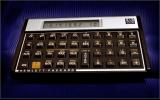
This is my HP-10C, the simplest HP Voyager series' model and the last to be released back in 1982. After 40 years (as of 2022), it still looks and works great.
See the full description and other details in the link above this one.

This is a close-up detail of my HP-10C, the simplest HP Voyager series' model and the last to be released back in 1982. After 40 years (as of 2022), it still looks and works great.
See the full description and other details in the link above this one.

Long Live the HP-11C, (5 pages, includes a program to quickly and accurately find the sum of infinite alternating series, even divergent ones)

This is my HP-11C, the first Voyager I owned, which was given to me back in 1981 as a present by a close friend.
See the full description and other details in the link above this one.
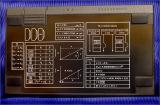
This is the back plate of my HP-11C, the first Voyager I owned, which was given to me back in 1981 as a present by a close friend.
Note: the Serial Number's last 5 digits have been replaced by 0s for privacy reasons.
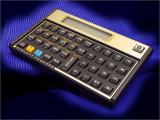
Long Live the HP-12C, (6-page article, includes a program to play a game of Bridge-It vs. the HP-12C)
Tried and Tricky Trigonometrics, (10-page article, fits all 6 trigonometric functions accurately in a single program)
HP-12C Serendipitous Solver, (8-page article, finds roots of, and evaluates, Nth-degree polynomials quickly and accurately)

Long Live the HP-15C, (6 pages, includes a program to compute e = 2.71828+ to more than 200 digits using matrix operations)
HP-15C Nth-degree Polynomial Fitting, (7-page article, fits an Nth-degree polynomial to a set of data)

This is one of my HP-15C, the most capable Voyager Series model, a real marvel of engineering with the best ergonomy, most advanced capabilities and batteries that last forever.
See the full description and other details in the link above this one.
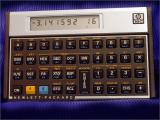
This is my HP-16C, a fantastic HP calculator with the outstanding quality inherent to all Voyager Series models, and which still looks and works like new despite being nearly 43 years old as of 2022.
The HP-16 is a specialized calculator intended for programmers (though I've never used it professionally), which natively works in bases 2, 8, 10 and 16 with word sizes from 1 to 64 bits. It features all kinds of dedicated operations such as shift and rotate functions, masking, bitwise logic, double precision multiplication and division, plus standard floating point arithmetic with square root and 1/x, and advanced programming with labels, loops, subroutines, flags and tests. It also has reallocatable memory between program steps and registers where the number or registers depends as well on the specified word size.
Precisely that very feature (increasing the number of available registers by decreasing the word size) is made good use of in the first article linked below which I wrote to commemorate the HP-16C, while the second article demonstrates how it's quite possible to implement scientific functions in this wonderful calc:
Long Live the HP-16C, (5-page article, includes a program to solve the Hanoi Towers puzzle with N disks)
Boldly Going - HP-16C Scientific Functions Part 2, (7 pages, implements 7 inverse functions: ln, sin-1, cos-1, tan-1, sinh-1, cosh-1 and tanh-1)

This is my HP-16C, a fantastic HP calculator with the outstanding quality inherent to all Voyager Series models, and which still looks and works like new despite being nearly 43 years old as of 2022.
See the full description and other details in the link above this one.
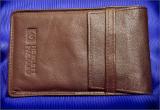
This is a leather-like case for all models of the HP Voyager Series, i.e.: HP-10C, HP-11C, HP-12C, HP-15C and HP-16C. It perfectly fits and keeps them well protected besides looking real classy. I got one for every Voyager calc I own plus another one for my HP42S as well. Recommended.
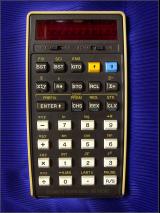
This is my very first HP calculator, the wonderful HP-25, the smallest and cheapest HP programmable calculator at the time. Released in 1975 (some 47 years ago as of 2022) it still looks and works perfectly.
It has 10-digit with 2-digit exponent, classic RPN stack, 8 storage registers with full storage arithmetic, a vast range of math functions including statistics, solid build and very small size, bright LED display fully useable in very low light or even utter darkness, excellent reliable keyboard, extremely good and comprehensive documentation (including tons of good application programs for all disciplnes), good programmability (49 fully-merged steps) with tests, branching, and single-step execution for debugging, etc. Also, an updated version, the HP-25C, augmented it with Continuous Memory, another first at the time.
You'd need to have lived through those times in order to fully understand what the HP-25 meant for both professionals and students like me back then, but failing that, you can find some of my programs for it in the HP Calculator Programs section in this very site, which will give you a fair idea. Meanwhile, you should really have a look at this Article of mine for a detailed review, including two truly amazing sample programs for you to see for yourself what it could do when pushed to the absolute max:
Long Live the HP-25, (7 pages, includes programs to solve 1st-order differential equations using Runge-Kutta methods of 3rd and 4th order)
Also, have a look at the following programs I wrote which extensively discuss and feature the HP-25:HP-25 Solving 2nd-order differential equations, (solves 2nd-order differential equations of the form y”=f(x,y) using a 5th-order method)
HP-25 Gamma Function and Factorials, (accurately evaluates the Gamma function in the interval [1,2] and approximates factorials for real x)

This is my very first HP calculator, the wonderful HP-25, the smallest and cheapest HP programmable calculator at the time. Released in 1975 (some 47 years ago as of 2022) it still looks and works perfectly.
See the full description and other details in the link above this one.

This is my very first HP calculator, the wonderful HP-25, the smallest and cheapest HP programmable calculator at the time. Released in 1975 (some 47 years ago as of 2022) it still looks and works perfectly.
See the full description and other details in the link above this one.
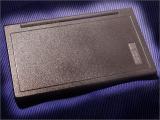
This is my HP28S, a Saturn-based model, the one and only RPL model I own which I bought just because I liked the form factor: foldable with a large graphic screen and twin keyboards, very elegant and ergonomic (save for the dreaded battery door). Right now it's 34 years old (as of 2022) and absolutely mint, matter of fact it's NIB actually, I've never ever used it other than to take these pics.
Back then it was a truly revolutionary model, a quantum leap in terms of paradigm and functionality over anything existing at the time, which essentially doomed classic RPN for good. It does symbolic math, has named variables, lots of data types, a very extensive function set, a powerful Solver, infrared printing, graph plotting, math in bases 2, 8, 10 and 16 with word sizes from 1 to 64 bits, catalog of all functions with their argument syntax, ... plus directories, custom menu, extra graphics manipulations. Last but most certainly not least, it has 32 Kb RAM instead of the nearly useless 2 Kb of its previous incarnation, the HP28C (which should've never been released with such crippling specification.)
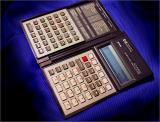
This is my HP28S open flat, a Saturn-based model, the one and only RPL model I own. It's 34 years old as of 2022.
See the full description and other details in the link above this one.
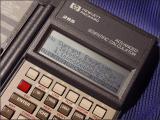
This is my HP28S, a Saturn-based model, the one and only RPL model I own, 34 years old as of 2022.
See the full description and other details in the link above this one.
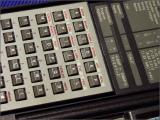
This is my HP28S, a Saturn-based model, the one and only RPL model I own, 34 years old as of 2022.
See the full description and other details in the link above.
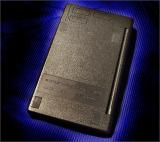
This is the back of my HP28S, a Saturn-based model, the one and only RPL model I own. It's 34 years old as of 2022.
Note: the Serial Number's last 5 digits have been replaced by 0s for privacy.
See the full description and other details in the links above this one.
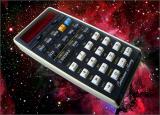
This is a mint HP-29C, an upgrade of the HP-25C introduced in 1979, with the exact same form factor and also having Continuous Memory but twice the program memory (98 steps), 30 storage registers, subroutines (at long last !!), indirection, loops, labels, insert/delete program steps and other goodies. As was the case with the HP-67/97 pair, a printing version with the identical functionality was released as well, the HP-19C
The immaculate HP-29C pictured here isn't mine but belongs to my life-long friend Jose Luis Chinchilla, whose impressive and extensive HP calc collection is partially depicted at the beginning of this Section.

This is a mint HP-29C, an upgrade of the HP-25C introduced in 1979.
See the full description and other details in the links above this one.
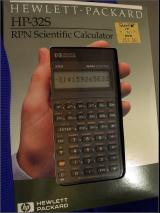
Behold my NIB (literally!) HP-32S !. Released in 1988, it was an inexpensive ($53.86 here) but powerful calculator, truly small and lightweight, which many (yours truly included) prefer to its sequel (the HP-32SII) for his elegant, non-cluttered keyboard (made possible by its menu system) yet it has a comprehensive function set including hyperbolics, Solver, Integrate, bases 2, 8, 10 and 16, statistics and complex-number support for arithmetic and transcendental functions. Alas, no complex stack a la HP-15C and no built-in matrix operations either.
Instead of the usual RPN registers, it has 27 variables (A-Z + i for indirection) which are allocated and deallocated on the fly to make the most of its somewhat meager 390 bytes of RAM available to the user for data and programs, which could use up to 7 levels of subroutines, indirection, looping, conditional tests, flags, labeled I/O and last but not least the excellent Solver which could solve for any variable. Also, batteries last for very long (though not as long as the Voyager Series' models, mind you).

One of my HP-32S, a most excellent and much loved classic RPN calculator, small, elegant, lightweight and powerful.
See the full description and other details in the link above this one.
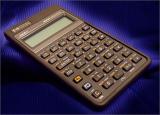
My HP-32SII, a 1991-released improvement over the original HP32S in some aspects, not so much in others. In particular the keyboard has a second shift key and frankly it's way too cluttered, but it does add equations and fractions for extra power.
See the HP32S description for extra details in the links above this one.
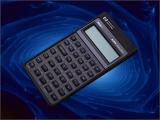
My friend FdR's HP-32SII, a 1991-released improvement over the original HP32S in some aspects, not so much in others.
See the full description and other details in the link above this one.

This is a truly like-new HP-34C, a relatively inexpensive calculator (as compared to the then recently introduced HP-41C) which at first glance seemed a disappointing return to old technology, what with the battery-hogging red LED display and no alphanumerics, mass storage or expandability, but as a very important first it was a relatively cheap model to the point of being affordable by students and thus it sold like cakes, so much in fact that to further boost the sales HP Spain commissioned an Advanced Math Solutions Book for it geared to them, which we duly wrote (it sold like cakes too).
The HP-34C featured many advanced capabilities (some of them state-of-the art at the time), such as automatic memory allocation, full programmability with six levels of subroutine nesting (eat your heart out, HP-25C ! ), labels, full indirect addressing, insertion/deletion of program steps, flags, conditionals, loops and so on, Gamma function, linear regression and a ground-breaking first: numerical Solve and Integrate, plus so many functions and features that it had three prefix keys to cater for all of them in the nice little keyboard.
All in all, a marvelous little calculator that was immensely fun to program, we had a really good time easily fitting quite complex programs in it. Alas, I don't currently own one so the immaculate HP-34C pictured here belongs to another life-long friend of mine, Fernando del Rey. His "mini-collection" is much smaller than my own (let alone Jose Luis Chinchilla's !) but does include some mint models not in mine (wish they were!).
Have a look at the following articles and programs I wrote which extensively discuss and feature the HP-34C:
Long Live the HP-34C, (9 pages, with full description and history, includes fond personal remembrances and a 66-step application program)
Loan Amortization Schedule, (generates either a complete amortization schedule showing each period of a fully amortized loan or a partial schedule between two given periods)
Summation of Alternating Series, (quickly and accurately finds the sum of infinite alternating series, even divergent ones [Euler Sum] )
Double Integrals, (computes the numeric value of a definite double integral of a user-specified f(x,y) between given limits)
Solving Quartic Equations, (computes simultaneously and non-iteratively all four real and/or complex roots of a general 4th-degree (or less) polynomial equation with real coefficients)
Nonlinear Equations Systems, (solves a system of two arbitrary nonlinear equations in two variables)
Factoring-GCD-Decimal to Fraction, (factorizes an integer into its prime factors, computes the GCD of two integers and finds integer fractions which best approximate a given value)
Memory Game and Trainer, (challenges your memory by testing your ability to remember what you’ve just seen and offering afterwards an accurate comment on your performance)
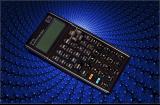
My HP-35s, an early model which was presented to me at the time it was released. It's in the style of vintage HP RPN calculators, trying to mimic their classic look-and-feel while implementing modern advanced features such as algebraic equations (which can be used as alphanumeric prompts), complex-number and 3D-vector operations, Solve, Integrate, fractions, non-decimal bases, and good programming features plus a 2-line x 14-character dot-matrix LCD display and much more memory, 30 Kb, which is good for 800+ registers (each of which can contain a 3-valued vector, so theoretically you can store ~2,400 floating-point values at once).
Alas, it has no mass storage capabilities at all such as a card reader, let alone USB, so you can't save/load your programs and data. On the positive side, it uses two CR-2032 batteries which last for many months.
Most regrettably, it also has many bugs (20+ and counting), some of which are quite annoying or even show-stopping, which HP never bothered to correct. Furthermore, some important features are very poorly implemented, such as complex-number and vector handling, with many important operations and functions missing, even pretty basic ones. Same for non-decimal base operations and last but not least, it's slow as molasses.
All in all, it makes for a poor user's experience, which is a real pity as otherwise the machine would be quite powerful and enjoyable to use.
Have a look at the following articles I wrote which extensively discuss and feature the HP-35s:
Storing Lotsa Lotsa Numbers, (short routines to conveniently store and recall more than 2,300 floating-point values in the indirect variables)
Boldly Going - Going Back to the Roots, (program to very quickly find real/complex roots of arbitrary equations with real/complex coefficients, as well as programs. Faster than Solve)
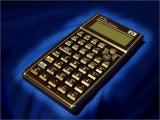
My HP-35s, an early model which was presented to me at the time it was released.
See the full description and other details in the link above this one.

The back plate of my HP-35s, an early model which was presented to me at the time it was released. Notice it doesn't seem to have a serial number engraved.
See the full description and other details in the link above this one.
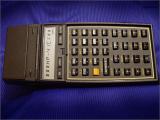
This is my HP-41CX, the best classic version of the HP-41C, a revolutionary alphanumeric model every HP-calc fan craved for at the time of its release some 40 years ago. I certainly did so I sold my beloved HP-67 to buy one and did wonders with it (synthetics !), both for fun and for profit. The 41CX is depicted here with its mandatory (if power-hungry) card reader and both Advantage and PPC modules plugged in (alas, not seen from this angle). With it and a full 40-card holder or two you had enormous computing power on the go.
The CX, introduced in 1983, was essentially a 41C on steroids: built-in Quad Memory module, Extended-Functions/Extended-Memory module, Timer module, plus text editor and extra functions not available anywhere else, while leaving all 4 ports free for other uses (e.g.: Advantage module, PPC/HEPAX/ZENROM module, Card Reader and Printer, or additional Extended Memory). A Classic-Dream-Machine if there ever was one, with dozens upon dozens of application-specific modules, Solution Books and dedicated peripherals, both HP's and 3rd-party's.
Have a look at these articles I wrote where the HP-41C is featured (as well as some of my programs for it in the HP Calculator Programs section in this very site):
Long Live the Advantage ROM, (N-th degree Polynomial Fit program included)
Know Thy Foe: A New Contender, (comparing HP-41C vs. SHARP PC-1211, two 41C programs and 6 SHARP programs included)
HP-41C Mate w King Bishop Knight Practice, (helps practice checkmate w/ King,Bishop,Knight (the user) vs. King (the program))

This is my HP-41CX, the best classic version of the HP-41C, a revolutionary alphanumeric model every HP-calc fan craved for at the time of its release some 43 years ago.
See the full description and other details in the link above this one.
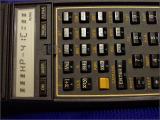
This is my HP-41CX, the best classic version of the HP-41C, a revolutionary alphanumeric model every HP-calc fan craved for at the time of its release some 43 years ago.
See the full description and other details in the links above this one.

This is a leather-like case for the HP-41 series models. It perfectly fits and allows for the card reader to be plugged in, with room to include some keyboard overlays while keeping the contents reasonably well protected against moderate impacts.
See the HP-41CX's full description and other details in the links above this one.
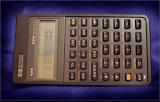
This is my HP-42S, the pinnacle of RPN calculators, a worthy successor to the HP-41C family which was intended to be completely compatible with it while adding incredible amounts of extra functionality such as full complex number support, matrices, Solve, Integrate, extended alphanumeric handling, named variables, graphics and menus. Add to that an enhanced, larger 2-line dot-matrix LCD display, much more RAM and faster speed and you have a real winner, a dream machine.
However at the last moment the product was badly maimed, probably to avoid cutting sales of the RPL models, and lost all kinds of I/O: no HP-IL, no card reader, no external storage, nothing but one-way communication with an I/R printer. It also lost all ports so no plug-in RAM and ROM modules, and its internal RAM was cut down from the possible 32 Kb to a mere 7 Kb. It was a real disaster for all of those people who, like me, didn't care at all for the RPL models and would rather have a very powerful, fast RPN programmable calculator as the HP-42S was intended to be from the start.
Alas, it wasn't to happen but it's still a fantastic, very worthwhile machine and, in emulated form running on various operating systems, incredibly fast.
Have a look at the following articles I wrote which extensively discuss and/or feature the HP-42S:Long Live the HP42S, (14-page article, includes a 'pro-looking' didactic program to solve the N-Queens puzzle in an NxN chessboard)
Boldly Going - Mandelbrot Set Area, (8-page article, includes a program to quickly compute an accurate estimation of Mandelbrot set's area)
Boldly Going - Outsmarting PROOT (42S), (includes a subprogram to find at once all real/cplex roots of a polynomial with real/cplex coeffs.)
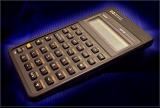
This is my HP-42S, the pinnacle of RPN calculators, a worthy successor to the HP-41C family, if regrettably crippled.
See the full description and other details in the link above this one.
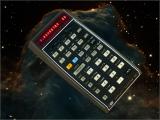
This is my friend Fernando del Rey's HP-55, 48 years old as of 2022. It was released in 1975, the second programmable model after the revolutionary HP-65 and in the same form factor. It boasted more than twice as many data registers (20) but no card reader and less than half the program memory, just 49 mostly unmerged steps, and a unique feature: an accurate quartz-based chronometer with 0.01 sec. resolution and the ability to take up to 10 splits while running, which could later be recalled and operated upon.
When I bought my first HP calculator, the awesome HP-25, I knew that it also had 49 steps available for programs but deemed that the HP-55 (which I couldn't afford), being much bigger and expensive would have superior programming capabilities. However, Fernando, who owned one (this one) told me that the HP-55's program steps were unmerged so in practice my HP-25 could store more than twice as many keystrokes and thus could run much more complex programs (say a 4th-order Runge-Kutta numerical solver for ODEs, hopelessly impossible to implement in his calc).
Apart from programming, we leisurely engaged in a weird challenge which consisted in trying to start and immediately stop the HP-55's timer by pressing the [R/S] key twice in quick succession, and we finally succeeded in having the timer display 0.01 sec. as the elapsed time, which of course was the absolute minimum achievable as a display of 0.00 would be indistinguishable from simply failing to start-stop the timer altogether. Ah, those were the days !
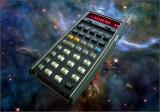
This is a mint HP-65, a ground-breaking first in the history of hand-held computation which was released in 1974 and boasted full programmability and even a card reader to save your programs (but not data) to extremely convenient, easy-to-carry magnetic cards.
It featured 100 partially-merged program steps, 9 storage registers (though R9 was also used by trigonometric functions), labels, subroutines, looping, conditional tests, flags, insertion/deletion of program steps, and a healthy supply of mathematical functions as well as base conversions, D.MS conversions and arithmetic, factorial and even functions useful for programming such as INT, [FRAC] and ABS. All in all, a true marvel which became and object of desire for every engineer and professionals in general. Extremely expensive at the time but if you could afford it, you wanted it bad.
I don't own one so the immaculate HP-65 pictured here isn't mine (wish it were!) but belongs to my life-long friend Jose Luis Chinchilla whose impressive and extensive HP calc collection is partially depicted at the beginning of this Section.

This is a mint HP-65, a ground-breaking first in the history of hand-held computation which was released in 1974
It was the most powerful programmable calculator at the time, a truly (if very expensive) marvel which introduced true, significant computing power, and handheld to boot. And to add praise to excellence, not only was it programmable but you could record your programs on magnetic cards using its awesome built-in card reader, all in a small, sleek body which perfectly fitted your hand.
It had 100 partially-merged program steps, 9 storage registers (with arithmetic), subroutines, conditional tests, branching, looping, and 51 math and scientific functions. All in all, it seemed like Sci-Fi at the time and everyone who could afford it immediately wanted one (myself included, but I couldn't afford it, mind you). Back plate with useful instructions.
See more details ot this particular calc in the links above this one.
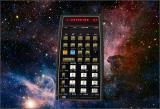
This is my friend Fernando del Rey's HP-67, 46-yo as of 2022. It was released in 1976 (together with its printing desktop sibling, the HP-97), the third programmable model after the ground-breaking HP-65 and in approximately the same form factor. Unlike the HP-55 and the HP-25, the HP-67 was far superior to the HP-65, with about three times the data registers (26) and more than twice the program steps (224) which to add insult to injury were fully merged, up to three keystrokes in a single step. Also, it had an advanced card reader which could store and read not just programs but also data and status info, and even merge program segments under program control. All in all, a dream come true.
Its programming capabilities were also far superior, with labels, easy program editing, subroutine levels, rapid reverse branching and indirection for most everything, plus several flavours of flags among many other goodies. Of course I wanted one ASAP and would do whatever to get it, including saving the considerable money (39.500 pts at the time, about two-month wages') and selling (with a heavy heart) my beloved, trusty HP-25 to try and raise the money faster. I eventually succeeded and owning it, programming it, using it in my Engineering classes was one of the happiest times in my life. I wrote scores of complex programs for it and submitted many of them to the PPC Journal and the HP Users Library, among others.
Fernando also bought one at the very same time that I did (in fact we bought them together) and we had some extremely good times programming them and engaging in friendly contests (he also subscribed to PPC as well). Unlike him, however, I eventually had to sell it to help finance the new HP-41C, which I deeply regret to this day.
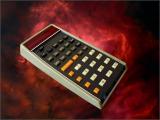
This is a very nice, like new HP-70, a relatively inexpensive financial calculator in the wake of the more expensive HP-80, which still included the TVM solver but not many other functions from its sibling, including dates arithmetic, bond price and yield, averaging, etc. It also had two storage registers, M and K (which upon power-up was initialized to 12) and M+ was also available (but not K+ or M-, Mx, etc). I saw one shortly after buying my HP-25 more than forty years ago, and found its color scheme quite unappealing, what with the bright orange keys, which I thought it was a very poor election for a financial model. Nevertheless it was soon obsoleted by the cheaper and more capable HP-22 so it's quite rare nowadays.
All the same, I don't own one so the immaculate HP-70 pictured here isn't mine but belongs to my life-long friend Jose Luis Chinchilla whose impressive and extensive HP calc collection is partially depicted at the beginning of this Section.
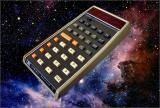
This is a very nice, like new HP-70, a relatively inexpensive financial calculator.
See the full description and other details in the link above this one.

This is my very first HP-71B, which I got back in 1986 so it's 36 year old as of 2022, and as you can see it's still absolutely as new and works flawlessly. Here it's depicted with a CMT 128 Kb RAM Memory Module plugged in the card reader port and perfectly matching the HP-71B's looks. I found the included card reader mostly useless for a number of reasons, so I eventually substituted it for the much more useful 128 Kb module, which can hold the equivalent of 200 magnetic cards at once, all of it instantly available.
Before getting this HP-71B I had been privy to a pre-production model before its release (it paid having friends at local HP headquarters !), which was lent to me for a weekend so that I could try it and see how I liked it. In a word, I found it awesome in the extreme, many many times faster than the HP-41C (though still 4 times slower than the much bigger and less powerful HP-75C), 16 Kb seemed like infinite RAM as compared to the HP-41C too (let alone when fitted with the 128 Kb module) and expandable to 512 Kb (in a handheld device !!), awesome HP-IL capabilities for interfacing with all kinds of peripherals and instruments at speeds many time faster than (again!) the HP-41C, the best BASIC dialect you could dream of and incredibly powerful plug-in ROMs such as my all-time favorite, the Math ROM which provides unbeatable math capabilities, even surpassing the full-size PCs of the time.
Thus, I was in love with the HP-71B and as soon as it was released I convinced my boss to get one for me (I couldn't afford the expense) with card-reader and HP-IL module fitted-in, and I bought the Math ROM with my own money (expensive but it had top priority for me, I'd rather not eat !). I wrote lots of software for it, both for profit and for fun (lots too !!) and in time got several more HP-71B, this time for peanuts as the second-hand market was flooded with thousands of them discarded by some UK Government agency (the NHS), so you probably can get one cheap too. Also, there's a number of very good emulators for MS-DOS, Windows and Android, most for free, so you can try one if you want.
Have a look at the following articles I wrote which extensively discuss and/or feature the HP-71B:
Long Live the HP-71B, (full description and history, includes a Text Stereograms generator program)
HP-71B Modest Mater, (program to solve Mate-in-N chess problems)
HP-71B Math ROM Bakers Dozen (Vol. 1), (many tips and useful code snippets, first part)
HP-71B Math ROM Bakers Dozen (Vol. 2), ((many tips and useful code snippets, second part))
HP-71B Short and Sweet Sudoku Solver, (program to solve any Sudoku puzzle)
HP-71B Sudoku Solver Sublime Sequel, (enhancement to the program to solve any Sudoku puzzle)
HP-71B Sudoku Generator and Coach, (program to generate new Sudoku puzzles and coach you to manually solve any puzzle)
HP-71B Fantastic FOUR, (multiprecision multiplication using Fast Fourier Transforms)
HP-71B Minimax Polynomial Fit, (program to fit a set of data to the very best possible polynomial)
25 years of Othello, (My story with Othello, includes a program to play Othello versus the machine)
Small Fry - Primes Acounting, (routine to very quickly count primes on a given interval with excellent accuracy)
Small Fry - Let's Be Rational, (routine to convert reals to fractions and find their continued fracton form)
Boldly Going - Matrix Square Root, (routine to compute the square root of a given matrix)
Boldly Going - Identifying Constants, (program to find the symbolic expression which evaluates to a given numeric value, many applications)
HP-71B Advanced Uses of STRNGLEX, (focuses on its less known keywords, whose capabilities are described with examples aplenty)
Boldly Going - Mandelbrot Set Area, (includes a program to quickly compute an accurate estimation of Mandelbrot set's area)
Math Pac 2 - My Comments and Proposals, (details the new keywords I propose for the HP-71 Math Pac 2, a new J-F Garnier's project)
Boldly Going - Abundant but Rare, (quickly and exactly finds an interesting and rare kind of so-called abundant numbers, up to 205-digit long)
Boldly Going - Eigenvalues and Friends, (computes the Characteristic Polynomial, Inverse and Determinant of real/complex matrices)
Boldly Going - Climbing Project Euler, (my story with Project Euler, includes 7 solved non-trivial problems with full details and comments)
Boldly Going - Outsmarting PROOT (71B), (subprogram+driver to find at once all real/cplex roots of polynomials with real/cplex coeffs.)
DOMINOKU – Swiftly Solving Domino Grids, (solves a newspaper-style domino puzzle which goes by assorted names (“Domino Logic”, etc.)
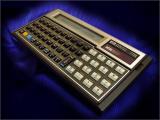
This is my very first HP-71B, which I got back in 1986 so it's now (2022) some 36 years-old and as you can see it's still absolutely as new and works flawlessly.
See the full description and other details in the link above this one.
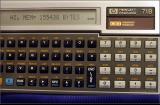
This is my very first HP-71B, depicted here with a 128 Kb CMT Memory Module plugged in the card reader port which, together with three 4K Memory Modules (not visible from this angle) makes for a whopping total of 156 Kb RAM as shown in the display. This much RAM allows for more than 100 sizable programs kept in memory at once, instantly available at all times, or you can use it to process enormous matrices (up to, say, 135x135 if real or 95x95 if complex) or arrays (up to nearly 20,000 real elements or 10,000 complex ones).
Nowadays we're used to have many Mb or even Gb available in a small handheld device but back in the middle 80's that much memory and processing power in a battery-powered handheld computer which you could use in the middle of nowhere was absolutely unheard of, a worldwide first. Most people couldn't afford the expense so it made little news but a lot of professionals were delighted in the extreme and literally jumped at the opportunity to get it no matter the cost.
Actually, I knew one of these people, who bought several HP-71B (one for actual use and the others as spares, just in case), fitted one with more than 200 Kb of RAM, Math ROM, HP-IL ROM and tape drive and went out to the mountains and other difficult and isolated places whatever the season to interconnect the HP-71B with a number of measuring devices and take many thousands of measurements on location, to later analyze the gathered data at home and conduct very complex geophysical studies of the terrain. He was paid well enough that the cost of the various HP-71B and peripherals was negligible in comparison, their acquisition really paid off.
See the full description of the HP-71B proper and other details in the link above.

This is my very first HP-71B, and here you can see the four frontal ports with three 4K Memory Modules and the Math ROM plugged in. The memory modules, which add 12 Kb to the built-in 16 Kb of RAM, plus the (not visible from this angle) 128 Kb CMT Memory Module plugged in the card reader port, makes for a whopping total of 156 Kb RAM which you could increase even further by simply plugging in third-party 32 Kb memory modules instead of the 4 Kb HP ones depicted here.
Add to that the awesome capabilities the Math ROM provides (complex variables and matrices, complex arithmetic and functions, full matrix operations, Hyperbolic and Gamma functions, Integrate, Solve, Fast Fourier Transform, etc.) and you have the most advanced mathematical and processing capabilities on the go for any device of its time.
See the full description and other interesting details in the links above.

This is a leather-like case for the HP-71B. It perfectly fits, with room to include the Quick Reference Guide and/or some keyboard overlays, and keeps the machine well protected against falls to the floor and impacts, but it has a terrible flaw in the (very) long run: after 20 or 30 years elapse the black mesh which lines the interior will disintegrate into a fine black powder that gets into all places: the LCD, the keyboard, the ports, inside the machine itself. The case can be recovered by thoroughly washing it till there are no traces of the black powder but the process of cleaning the HP-71B, while quite possible, is cumbersome and very time-consuming. The black powder doesn't seem to harm the machine, though.
If you've got one or more HP-71B inside these cases right now, you'd do well to inspect them carefully, and either store them out of the cases or place them in hermetically sealed plastic bags inside the cases, to prevent the eventual disintegration's nasty effects.
COPYRIGHT NOTICE
These articles, programs, pictures, their descriptions and other materials created by me
are (c) Valentin Albillo, and can be used freely for non-profit purposes
as long as (1) the contents aren't modified in any way and (2) the copyright is acknowledged.
In plain words, you can download them and use them for non-profit purposes but do not include
them in any media and/or site for which you're asking money, do not tamper with their contents and
do not say or imply that you created them or that you don't know who created them, you must
always give due credit to me.